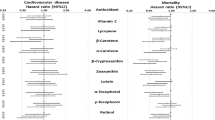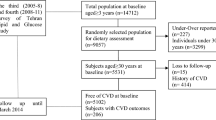Abstract
Systemic inflammation, oxidative stress, and atrial fibrosis are identified as the main mechanisms for atrial fibrillation (AF). Antioxidant micronutrients may have antiarrhythmic benefit in humans. We studied whether plasma carotenoids are related to the risk of AF in elderly subjects. The study population consisted of 1,847 Finnish subjects (620 women and 1,227 men) aged 61–82 years from the Kuopio Ischaemic Heart Disease Risk Factor study cohort. Plasma concentrations of carotenoids were measured by high-performance liquid chromatography. The multivariable-adjusted hazard ratios (HRs) and 95 % confidence intervals (CIs) of plasma carotenoids were analyzed using the Cox proportional hazard’s model. During a median follow-up of 2.8 years a total of 105 subjects developed incident AF. The HRs of AF among subjects with levels in the highest through the lowest tertile after adjustment for age, examination year, gender, systolic blood pressure, smoking, alcohol consumption, education, diabetes, use of antihypertensive medication, congestive heart failure, recurrent AF, prevalent coronary heart disease and baseline prevalence of myocardial infarction were 1.70 (95 % CI: 1.01–2.86, p = 0.047) for lutein, 1.99 (95 % CI: 1.14–3.48, p = 0.016) for zeaxanthin. Risk of AF was borderline significant for β-carotene (HR = 1.69, 95 % CI: 1.00–2.87, p = 0.050). Results remained unchanged, when season was added to the multivariable model. Lycopene, β-cryptoxanthin, α-carotene and total carotenoids were not associated with the risk of AF. Results of the present study suggest that low plasma concentrations of lutein and zeaxanthin were associated with an increased risk of AF in elderly population.

Similar content being viewed by others
References
Go AS, Hylek EM, Phillips KA, Chang Y, Henault LE, Selby JV, et al. Prevalence of diagnosed atrial fibrillation in adults: national implications for rhythm management and stroke prevention: the AnTicoagulation and Risk Factors in Atrial Fibrillation (ATRIA) Study. JAMA. 2001;285:2370–5.
Stewart S, Hart CL, Hole DJ, McMurray JJ. A population-based study of the long-term risks associated with atrial fibrillation: 20-year follow-up of the Renfrew/Paisley study. Am J Med. 2002;113:359–64.
Wang TJ, Larson MG, Levy D, Vasan RS, Leip EP, Wolf PA, et al. Temporal relations of atrial fibrillation and congestive heart failure and their joint influence on mortality: the Framingham Heart Study. Circulation. 2003;107:2920–5.
Friberg J, Scharling H, Gadsbøll N, Truelsen T, Jensen GB. Copenhagen City Heart Study. Comparison of the impact of atrial fibrillation on the risk of stroke and cardiovascular death in women vs men (the Copenhagen City Heart Study). Am J Cardiol. 2004;94:889–94.
Miyasaka Y, Barnes ME, Bailey KR, Cha SS, Gersh BJ, Seward JB, et al. Mortality trends in patients diagnosed with first atrial fibrillation: a 21-year community-based study. J Am Coll Cardiol. 2007;49:986–92.
Zeng X, Li Q, Zhang M, Wang W, Tan X. Green tea may be benefit to the therapy of atrial fibrillation. J Cell Biochem. 2011;112:1709–12.
Cotelle N. Role of flavonoids in oxidative stress. Curr Top Med Chem. 2001;1:569–90.
Young AJ, Lowe GM. Antioxidant and prooxidant properties of carotenoids. Arch Biochem Biophys. 2001;385:20–7.
Lee EH, Faulhaber D, Hanson KM, Ding W, Peters S, Kodali S, et al. Dietary lutein reduces ultraviolet radiation-induced inflammation and immunosuppression. J Invest Dermatol. 2004;122:510–7.
Salonen JT. Is there a continuing need for longitudinal epidemiologic research? The Kuopio Ischaemic Heart Disease Risk Factor Study. Ann Clin Res. 1988;20:46–50.
Fuster V, Rydén LE, Asinger RW, Cannom DS, Crijns HJ, Frye RL, et al. ACC/AHA/ESC guidelines for the management of patients with atrial fibrillation: executive summary a report of the American College of Cardiology/American Heart Association Task Force on Practice Guidelines and the European Society of Cardiology Committee for practice guidelines and policy conferences (Committee to develop guidelines for the management of patients with atrial fibrillation) developed in collaboration with the North American Society of pacing and electrophysiology. Circulation. 2001;104:2118–50.
Karppi J, Nurmi T, Olmedilla-Alonso B, Granado-Lorencio F, Nyyssönen K. Simultaneous measurement of retinol, alpha-tocopherol and six carotenoids in human plasma by using an isocratic reversed-phase HPLC method. J Chromatogr B Analyt Technol Biomed Life Sci. 2008;867:226–32.
Laukkanen JA, Kurl S, Rauramaa R, Lakka TA, Venäläinen JM, Salonen JT. Systolic blood pressure response to exercise testing is related to the risk of acute myocardial infarction in middle-aged men. Eur J Cardiovasc Prev Rehabil. 2006;13:421–8.
Räsänen J, Kauhanen J, Lakka TA, Kaplan GA, Salonen JT. Religious affiliation and all-cause mortality: a prospective population study in middle-aged men in Eastern Finland. Int J Epidemiol. 1996;25:1244–9.
Deo R, Katz R, Kestenbaum B, Fried L, Sarnak MJ, Psaty BM, et al. Impaired kidney function and atrial fibrillation in elderly subjects. J Card Fail. 2010;16:55–60.
Israel CW, Grönefeld G, Ehrlich JR, Li YG, Hohnloser SH. Long-term risk of recurrent atrial fibrillation as documented by an implantable monitoring device: implications for optimal patient care. J Am Coll Cardiol. 2004;43:47–52.
Disertori M, Lombardi F, Barlera S, Maggioni AP, Favero C, Franzosi MG, et al. Clinical characteristics of patients with asymptomatic recurrences of atrial fibrillation in the Gruppo Italiano per lo Studio della Sopravvivenza nell’Infarto Miocardico-Atrial Fibrillation (GISSI-AF) trial. Am Heart J. 2011;162:382–9.
Verdecchia P, Reboldi G, Gattobigio R, Bentivoglio M, Borgioni C, Angeli F, et al. Atrial fibrillation in hypertension: predictors and outcome. Hypertension. 2003;41:218–23.
Himmelmann A. Hypertension: an important precursor of heart failure. Blood Press. 1999;8:253–60.
Liu T, Li L, Korantzopoulos P, Liu E, Li G. Statin use and development of atrial fibrillation: a systematic review and meta-analysis of randomized clinical trials and observational studies. Int J Cardiol. 2008;126:160–70.
Mihm MJ, Yu F, Carnes CA, Reiser PJ, McCarthy PM, Van Wagoner DR, et al. Impaired myofibrillar energetics and oxidative injury during human atrial fibrillation. Circulation. 2001;104:174–80.
McNulty H, Jacob RF, Mason RP. Biologic activity of carotenoids related to distinct membrane physicochemical interactions. Am J Cardiol. 2008;22:20D–9D.
Muzakova V, Kand’ar R, Meloun M, Skalicky J, Kralovec K, Zakova P, et al. Inverse correlation between plasma Beta-carotene and interleukin-6 in patients with advanced coronary artery disease. Int J Vitam Nutr Res. 2010;80:369–77.
D’Adamo CR, Miller RR, Shardell MD, Orwig DL, Hochberg MC, Ferrucci L, et al. Higher serum concentrations of dietary antioxidants are associated with lower levels of inflammatory biomarkers during the year after hip fracture. Clin Nutr. 2012;31:659–65.
Di Tomo P, Canali R, Ciavardelli D, Di Silvestre S, De Marco A, Giardinelli A, et al. beta-Carotene and lycopene affect endothelial response to TNF-alpha reducing nitro-oxidative stress and interaction with monocytes. Mol Nutr Food Res. 2012;56:217–27.
Milde J, Elstner EF, Grassmann J. Synergistic effects of phenolics and carotenoids on human low-density lipoprotein oxidation. Mol Nutr Food Res. 2007;51:956–61.
Böhm F, Edge R, Truscott TG. Interactions of dietary carotenoids with singlet oxygen (1O2) and free radicals: potential effects for human health. Acta Biochim Pol. 2012;59:27–30.
van Het Hof KH, West CE, Weststrate JA, Hautvast JG. Dietary factors that affect the bioavailability of carotenoids. J Nutr. 2000;130:503–6.
Acknowledgments
The authors are grateful to the staff of Institute of Public Health and Clinical Nutrition at the University of Eastern Finland for helping with data collection in the study. J.K. participated in study design, statistical analysis and drafted the manuscript and provided feedback on the work. S.K. participated in the design of the study and provided feedback on the work. T.H.M. participated in the design of the study. K.R. preformed statistical analyses. J.A.L. participated in the design of the study and provided feedback on the work. J.K., S.K. and J.A.L are responsible for the study. All authors collaborated interactively, and read and approved the final version of this article. S.K. will act as a guarantor for the paper. This work was supported by the EVO funding of Lapland Central Hospital and Orion-Farmos Research Foundation.
Conflict of interest
The authors declare that they have no conflict of interest.
Author information
Authors and Affiliations
Corresponding author
Rights and permissions
About this article
Cite this article
Karppi, J., Kurl, S., Mäkikallio, T.H. et al. Low levels of plasma carotenoids are associated with an increased risk of atrial fibrillation. Eur J Epidemiol 28, 45–53 (2013). https://doi.org/10.1007/s10654-012-9753-z
Received:
Accepted:
Published:
Issue Date:
DOI: https://doi.org/10.1007/s10654-012-9753-z




